gas type JEEP CHEROKEE 2020 Owner handbook (in English)
[x] Cancel search | Manufacturer: JEEP, Model Year: 2020, Model line: CHEROKEE, Model: JEEP CHEROKEE 2020Pages: 332, PDF Size: 8.87 MB
Page 12 of 332
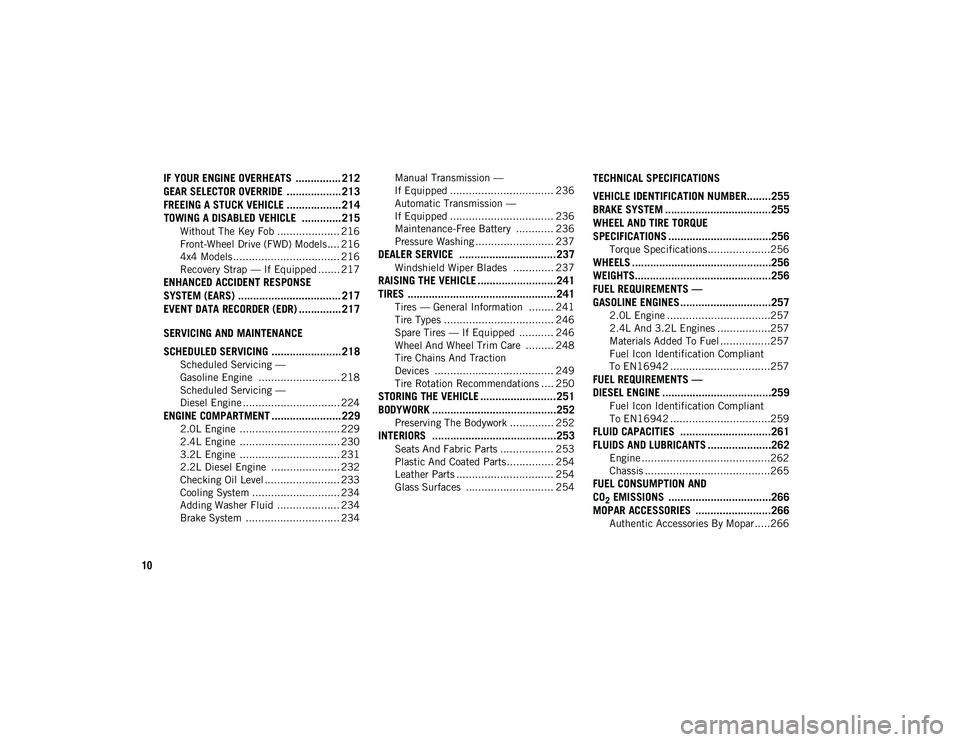
10
IF YOUR ENGINE OVERHEATS ............... 212
GEAR SELECTOR OVERRIDE .................. 213FREEING A STUCK VEHICLE .................. 214TOWING A DISABLED VEHICLE ............. 215
Without The Key Fob .................... 216
Front-Wheel Drive (FWD) Models .... 216
4x4 Models .................................. 216
Recovery Strap — If Equipped ....... 217
ENHANCED ACCIDENT RESPONSE
SYSTEM (EARS) .................................. 217
EVENT DATA RECORDER (EDR) .............. 217
SERVICING AND MAINTENANCE
SCHEDULED SERVICING ....................... 218
Scheduled Servicing —
Gasoline Engine .......................... 218 Scheduled Servicing —
Diesel Engine ............................... 224
ENGINE COMPARTMENT ....................... 229
2.0L Engine ................................ 229
2.4L Engine ................................ 230
3.2L Engine ................................ 231
2.2L Diesel Engine ...................... 232
Checking Oil Level ........................ 233
Cooling System ............................ 234
Adding Washer Fluid .................... 234
Brake System .............................. 234 Manual Transmission —
If Equipped ................................. 236 Automatic Transmission —
If Equipped ................................. 236 Maintenance-Free Battery ............ 236
Pressure Washing ......................... 237
DEALER SERVICE ................................237
Windshield Wiper Blades ............. 237
RAISING THE VEHICLE ..........................241
TIRES .................................................241
Tires — General Information ........ 241
Tire Types ................................... 246
Spare Tires — If Equipped ........... 246
Wheel And Wheel Trim Care ......... 248
Tire Chains And Traction
Devices ...................................... 249 Tire Rotation Recommendations .... 250
STORING THE VEHICLE .........................251BODYWORK .........................................252
Preserving The Bodywork .............. 252
INTERIORS .........................................253
Seats And Fabric Parts ................. 253
Plastic And Coated Parts............... 254
Leather Parts ............................... 254
Glass Surfaces ............................ 254
TECHNICAL SPECIFICATIONS
VEHICLE IDENTIFICATION NUMBER........255BRAKE SYSTEM ...................................255
WHEEL AND TIRE TORQUE
SPECIFICATIONS ..................................256
Torque Specifications ....................256
WHEELS ..............................................256
WEIGHTS.............................................256
FUEL REQUIREMENTS —
GASOLINE ENGINES ..............................257
2.0L Engine .................................257
2.4L And 3.2L Engines .................257
Materials Added To Fuel ................257
Fuel Icon Identification Compliant
To EN16942 ................................257
FUEL REQUIREMENTS —
DIESEL ENGINE ....................................259
Fuel Icon Identification Compliant
To EN16942 ................................259
FLUID CAPACITIES ..............................261
FLUIDS AND LUBRICANTS .....................262
Engine .........................................262
Chassis ........................................265
FUEL CONSUMPTION AND
CO
2 EMISSIONS ..................................266
MOPAR ACCESSORIES .........................266
Authentic Accessories By Mopar .....266
2020_JEEP_CHEROKEE_UG_RHD_UK.book Page 10
Page 113 of 332
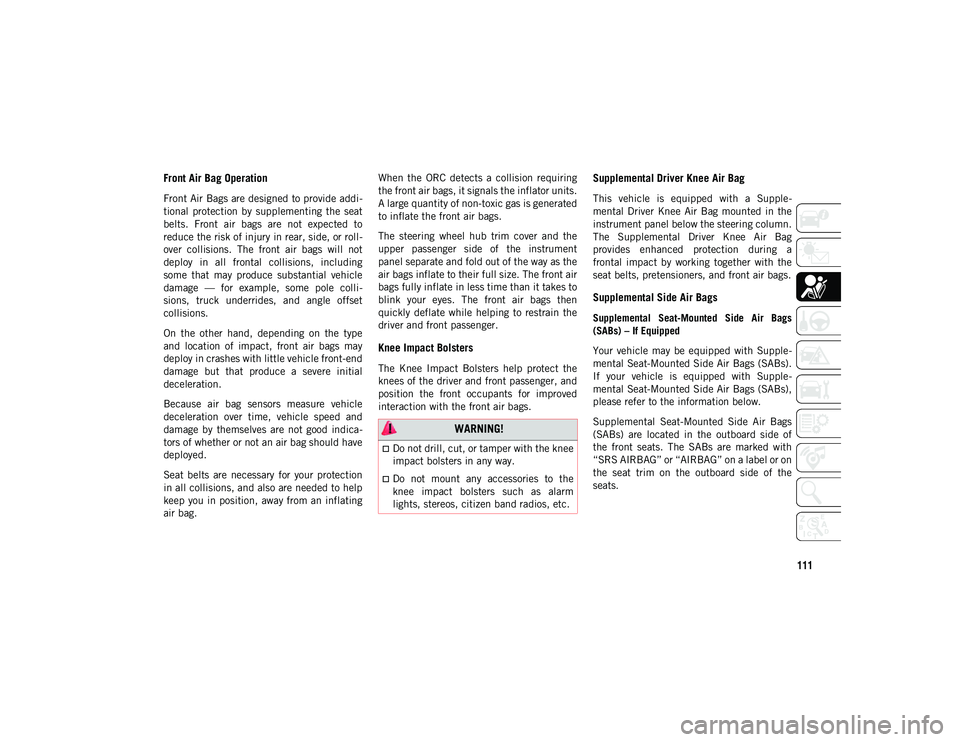
111
Front Air Bag Operation
Front Air Bags are designed to provide addi-
tional protection by supplementing the seat
belts. Front air bags are not expected to
reduce the risk of injury in rear, side, or roll -
over collisions. The front air bags will not
deploy in all frontal collisions, including
some that may produce substantial vehicle
damage — for example, some pole colli -
sions, truck underrides, and angle offset
collisions.
On the other hand, depending on the type
and location of impact, front air bags may
deploy in crashes with little vehicle front-end
damage but that produce a severe initial
deceleration.
Because air bag sensors measure vehicle
deceleration over time, vehicle speed and
damage by themselves are not good indica -
tors of whether or not an air bag should have
deployed.
Seat belts are necessary for your protection
in all collisions, and also are needed to help
keep you in position, away from an inflating
air bag. When the ORC detects a collision requiring
the front air bags, it signals the inflator units.
A large quantity of non-toxic gas is generated
to inflate the front air bags.
The steering wheel hub trim cover and the
upper passenger side of the instrument
panel separate and fold out of the way as the
air bags inflate to their full size. The front air
bags fully inflate in less time than it takes to
blink your eyes. The front air bags then
quickly deflate while helping to restrain the
driver and front passenger.
Knee Impact Bolsters
The Knee Impact Bolsters help protect the
knees of the driver and front passenger, and
position the front occupants for improved
interaction with the front air bags.
Supplemental Driver Knee Air Bag
This vehicle is equipped with a Supple
-
mental Driver Knee Air Bag mounted in the
instrument panel below the steering column.
The Supplemental Driver Knee Air Bag
provides enhanced protection during a
frontal impact by working together with the
seat belts, pretensioners, and front air bags.
Supplemental Side Air Bags
Supplemental Seat-Mounted Side Air Bags
(SABs) – If Equipped
Your vehicle may be equipped with Supple -
mental Seat-Mounted Side Air Bags (SABs).
If your vehicle is equipped with Supple -
mental Seat-Mounted Side Air Bags (SABs),
please refer to the information below.
Supplemental Seat-Mounted Side Air Bags
(SABs) are located in the outboard side of
the front seats. The SABs are marked with
“SRS AIRBAG” or “AIRBAG” on a label or on
the seat trim on the outboard side of the
seats.
WARNING!
Do not drill, cut, or tamper with the knee
impact bolsters in any way.
Do not mount any accessories to the
knee impact bolsters such as alarm
lights, stereos, citizen band radios, etc.
2020_JEEP_CHEROKEE_UG_RHD_UK.book Page 111
Page 175 of 332
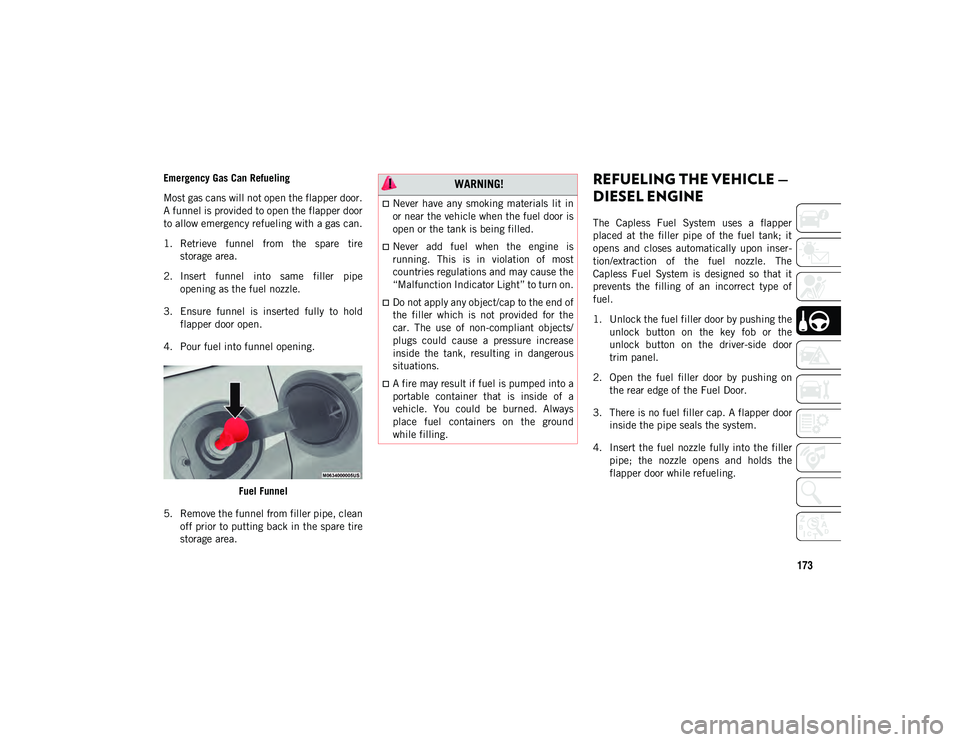
173
Emergency Gas Can Refueling
Most gas cans will not open the flapper door.
A funnel is provided to open the flapper door
to allow emergency refueling with a gas can.
1. Retrieve funnel from the spare tirestorage area.
2. Insert funnel into same filler pipe opening as the fuel nozzle.
3. Ensure funnel is inserted fully to hold flapper door open.
4. Pour fuel into funnel opening.
Fuel Funnel
5. Remove the funnel from filler pipe, clean off prior to putting back in the spare tire
storage area.REFUELING THE VEHICLE —
DIESEL ENGINE
The Capless Fuel System uses a flapper
placed at the filler pipe of the fuel tank; it
opens and closes automatically upon inser -
tion/extraction of the fuel nozzle. The
Capless Fuel System is designed so that it
prevents the filling of an incorrect type of
fuel.
1. Unlock the fuel filler door by pushing the unlock button on the key fob or the
unlock button on the driver-side door
trim panel.
2. Open the fuel filler door by pushing on the rear edge of the Fuel Door.
3. There is no fuel filler cap. A flapper door inside the pipe seals the system.
4. Insert the fuel nozzle fully into the filler pipe; the nozzle opens and holds the
flapper door while refueling.
WARNING!
Never have any smoking materials lit in
or near the vehicle when the fuel door is
open or the tank is being filled.
Never add fuel when the engine is
running. This is in violation of most
countries regulations and may cause the
“Malfunction Indicator Light” to turn on.
Do not apply any object/cap to the end of
the filler which is not provided for the
car. The use of non-compliant objects/
plugs could cause a pressure increase
inside the tank, resulting in dangerous
situations.
A fire may result if fuel is pumped into a
portable container that is inside of a
vehicle. You could be burned. Always
place fuel containers on the ground
while filling.
2020_JEEP_CHEROKEE_UG_RHD_UK.book Page 173
Page 176 of 332
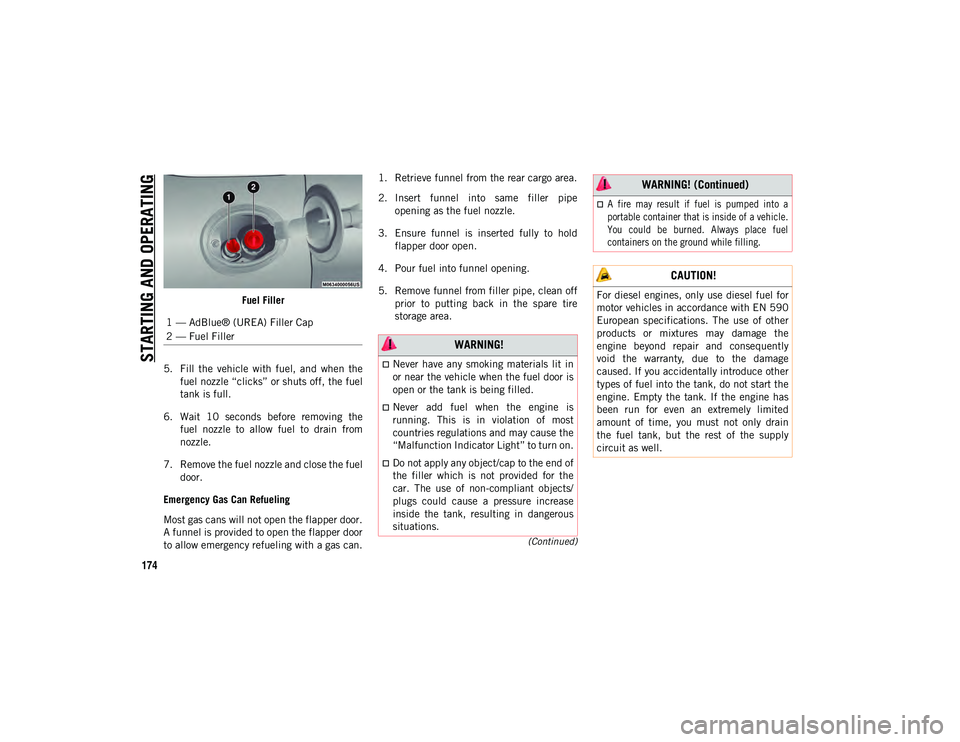
STARTING AND OPERATING
174
(Continued)
Fuel Filler
5. Fill the vehicle with fuel, and when the fuel nozzle “clicks” or shuts off, the fuel
tank is full.
6. Wait 10 seconds before removing the fuel nozzle to allow fuel to drain from
nozzle.
7. Remove the fuel nozzle and close the fuel door.
Emergency Gas Can Refueling
Most gas cans will not open the flapper door.
A funnel is provided to open the flapper door
to allow emergency refueling with a gas can. 1. Retrieve funnel from the rear cargo area.
2. Insert funnel into same filler pipe
opening as the fuel nozzle.
3. Ensure funnel is inserted fully to hold flapper door open.
4. Pour fuel into funnel opening.
5. Remove funnel from filler pipe, clean off prior to putting back in the spare tire
storage area.
1 — AdBlue® (UREA) Filler Cap
2 — Fuel Filler
WARNING!
Never have any smoking materials lit in
or near the vehicle when the fuel door is
open or the tank is being filled.
Never add fuel when the engine is
running. This is in violation of most
countries regulations and may cause the
“Malfunction Indicator Light” to turn on.
Do not apply any object/cap to the end of
the filler which is not provided for the
car. The use of non-compliant objects/
plugs could cause a pressure increase
inside the tank, resulting in dangerous
situations.
A fire may result if fuel is pumped into a
portable container that is inside of a vehicle.
You could be burned. Always place fuel
containers on the ground while filling.
CAUTION!
For diesel engines, only use diesel fuel for
motor vehicles in accordance with EN 590
European specifications. The use of other
products or mixtures may damage the
engine beyond repair and consequently
void the warranty, due to the damage
caused. If you accidentally introduce other
types of fuel into the tank, do not start the
engine. Empty the tank. If the engine has
been run for even an extremely limited
amount of time, you must not only drain
the fuel tank, but the rest of the supply
circuit as well.
WARNING! (Continued)
2020_JEEP_CHEROKEE_UG_RHD_UK.book Page 174
Page 235 of 332
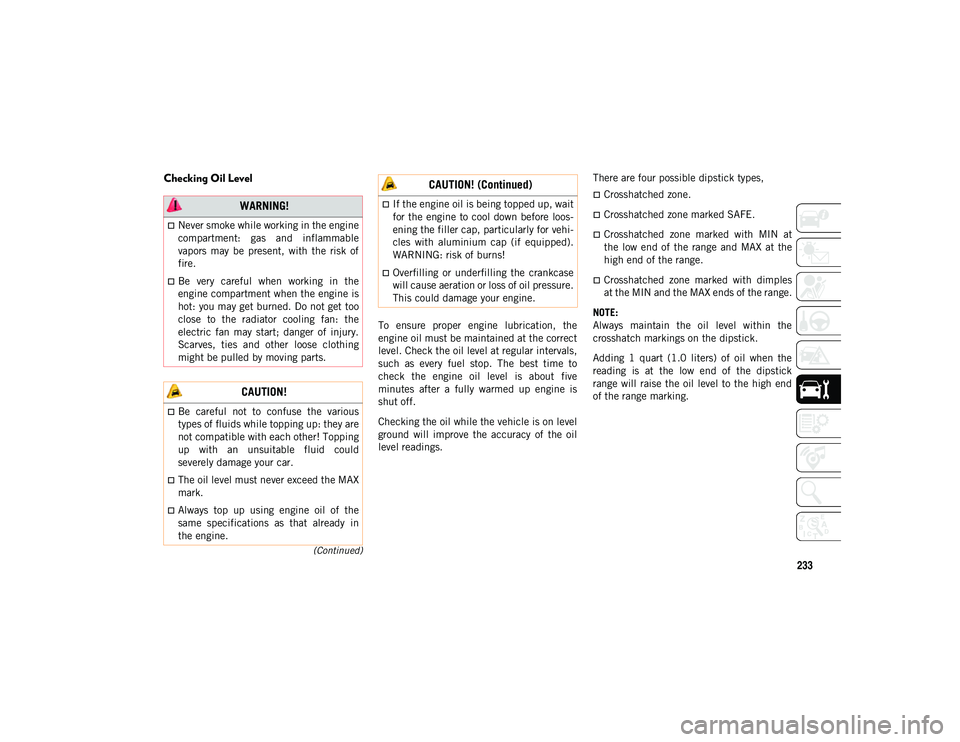
233
(Continued)
Checking Oil Level
To ensure proper engine lubrication, the
engine oil must be maintained at the correct
level. Check the oil level at regular intervals,
such as every fuel stop. The best time to
check the engine oil level is about five
minutes after a fully warmed up engine is
shut off.
Checking the oil while the vehicle is on level
ground will improve the accuracy of the oil
level readings.There are four possible dipstick types,
Crosshatched zone.
Crosshatched zone marked SAFE.
Crosshatched zone marked with MIN at
the low end of the range and MAX at the
high end of the range.
Crosshatched zone marked with dimples
at the MIN and the MAX ends of the range.
NOTE:
Always maintain the oil level within the
crosshatch markings on the dipstick.
Adding 1 quart (1.0 liters) of oil when the
reading is at the low end of the dipstick
range will raise the oil level to the high end
of the range marking.
WARNING!
Never smoke while working in the engine
compartment: gas and inflammable
vapors may be present, with the risk of
fire.
Be very careful when working in the
engine compartment when the engine is
hot: you may get burned. Do not get too
close to the radiator cooling fan: the
electric fan may start; danger of injury.
Scarves, ties and other loose clothing
might be pulled by moving parts.
CAUTION!
Be careful not to confuse the various
types of fluids while topping up: they are
not compatible with each other! Topping
up with an unsuitable fluid could
severely damage your car.
The oil level must never exceed the MAX
mark.
Always top up using engine oil of the
same specifications as that already in
the engine.
If the engine oil is being topped up, wait
for the engine to cool down before loos-
ening the filler cap, particularly for vehi -
cles with aluminium cap (if equipped).
WARNING: risk of burns!
Overfilling or underfilling the crankcase
will cause aeration or loss of oil pressure.
This could damage your engine.
CAUTION! (Continued)
2020_JEEP_CHEROKEE_UG_RHD_UK.book Page 233
Page 259 of 332
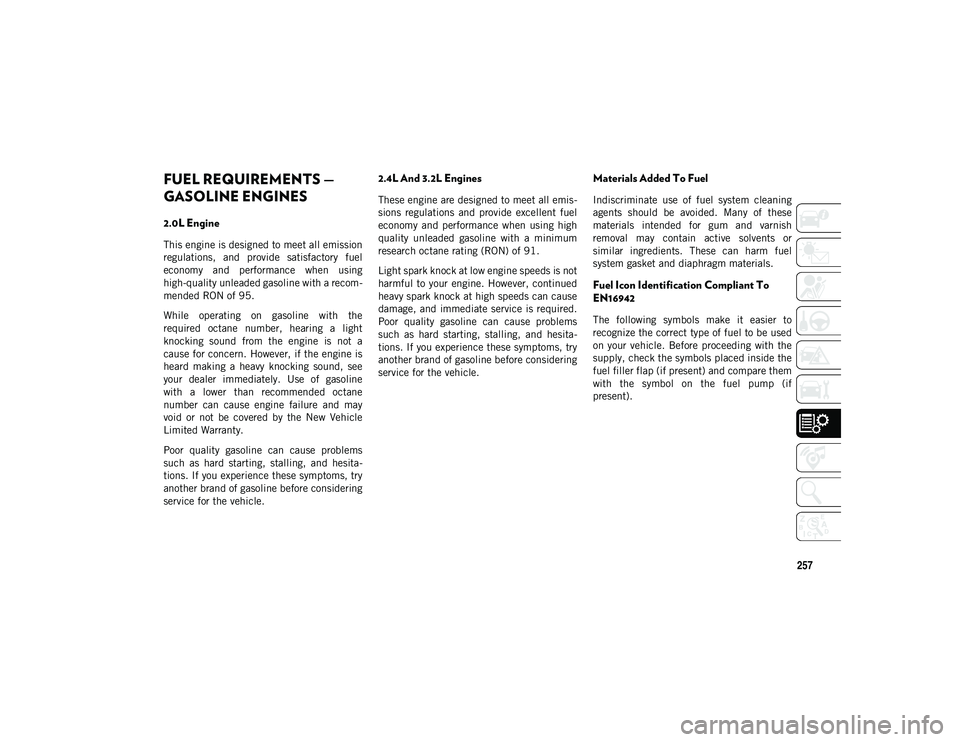
257
FUEL REQUIREMENTS —
GASOLINE ENGINES
2.0L Engine
This engine is designed to meet all emission
regulations, and provide satisfactory fuel
economy and performance when using
high-quality unleaded gasoline with a recom-
mended RON of 95.
While operating on gasoline with the
required octane number, hearing a light
knocking sound from the engine is not a
cause for concern. However, if the engine is
heard making a heavy knocking sound, see
your dealer immediately. Use of gasoline
with a lower than recommended octane
number can cause engine failure and may
void or not be covered by the New Vehicle
Limited Warranty.
Poor quality gasoline can cause problems
such as hard starting, stalling, and hesita -
tions. If you experience these symptoms, try
another brand of gasoline before considering
service for the vehicle.
2.4L And 3.2L Engines
These engine are designed to meet all emis -
sions regulations and provide excellent fuel
economy and performance when using high
quality unleaded gasoline with a minimum
research octane rating (RON) of 91.
Light spark knock at low engine speeds is not
harmful to your engine. However, continued
heavy spark knock at high speeds can cause
damage, and immediate service is required.
Poor quality gasoline can cause problems
such as hard starting, stalling, and hesita -
tions. If you experience these symptoms, try
another brand of gasoline before considering
service for the vehicle.
Materials Added To Fuel
Indiscriminate use of fuel system cleaning
agents should be avoided. Many of these
materials intended for gum and varnish
removal may contain active solvents or
similar ingredients. These can harm fuel
system gasket and diaphragm materials.
Fuel Icon Identification Compliant To
EN16942
The following symbols make it easier to
recognize the correct type of fuel to be used
on your vehicle. Before proceeding with the
supply, check the symbols placed inside the
fuel filler flap (if present) and compare them
with the symbol on the fuel pump (if
present).
2020_JEEP_CHEROKEE_UG_RHD_UK.book Page 257
Page 261 of 332
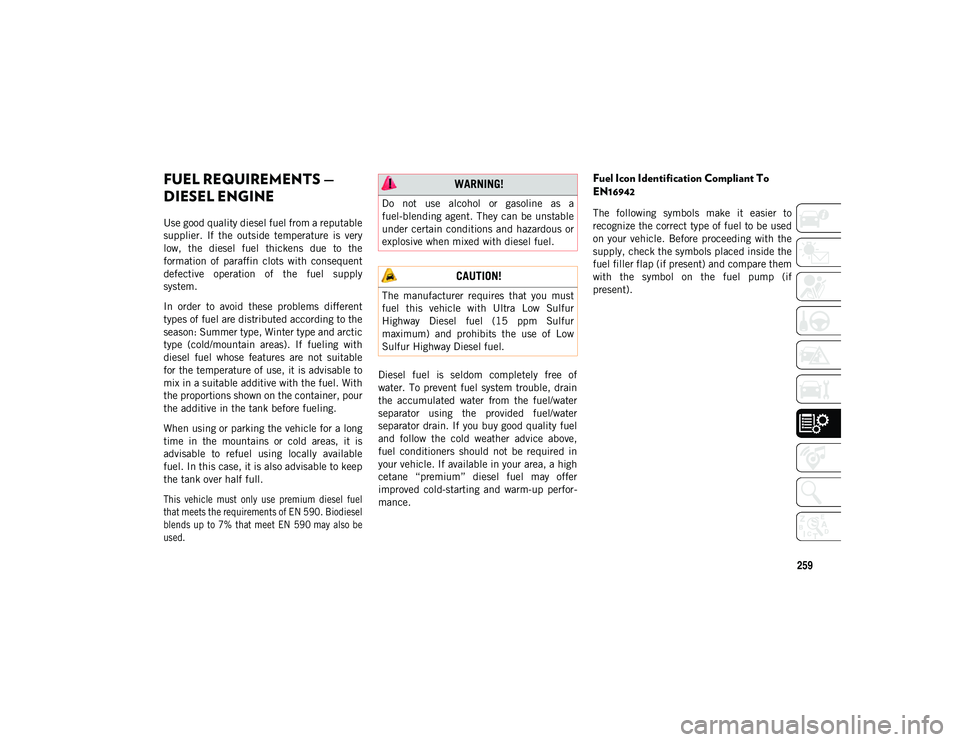
259
FUEL REQUIREMENTS —
DIESEL ENGINE
Use good quality diesel fuel from a reputable
supplier. If the outside temperature is very
low, the diesel fuel thickens due to the
formation of paraffin clots with consequent
defective operation of the fuel supply
system.
In order to avoid these problems different
types of fuel are distributed according to the
season: Summer type, Winter type and arctic
type (cold/mountain areas). If fueling with
diesel fuel whose features are not suitable
for the temperature of use, it is advisable to
mix in a suitable additive with the fuel. With
the proportions shown on the container, pour
the additive in the tank before fueling.
When using or parking the vehicle for a long
time in the mountains or cold areas, it is
advisable to refuel using locally available
fuel. In this case, it is also advisable to keep
the tank over half full.
This vehicle must only use premium diesel fuel
that meets the requirements of EN 590. Biodiesel
blends up to 7% that meet EN 590 may also be
used.
Diesel fuel is seldom completely free of
water. To prevent fuel system trouble, drain
the accumulated water from the fuel/water
separator using the provided fuel/water
separator drain. If you buy good quality fuel
and follow the cold weather advice above,
fuel conditioners should not be required in
your vehicle. If available in your area, a high
cetane “premium” diesel fuel may offer
improved cold-starting and warm-up perfor
-
mance.
Fuel Icon Identification Compliant To
EN16942
The following symbols make it easier to
recognize the correct type of fuel to be used
on your vehicle. Before proceeding with the
supply, check the symbols placed inside the
fuel filler flap (if present) and compare them
with the symbol on the fuel pump (if
present).
WARNING!
Do not use alcohol or gasoline as a
fuel-blending agent. They can be unstable
under certain conditions and hazardous or
explosive when mixed with diesel fuel.
CAUTION!
The manufacturer requires that you must
fuel this vehicle with Ultra Low Sulfur
Highway Diesel fuel (15 ppm Sulfur
maximum) and prohibits the use of Low
Sulfur Highway Diesel fuel.
2020_JEEP_CHEROKEE_UG_RHD_UK.book Page 259
Page 265 of 332
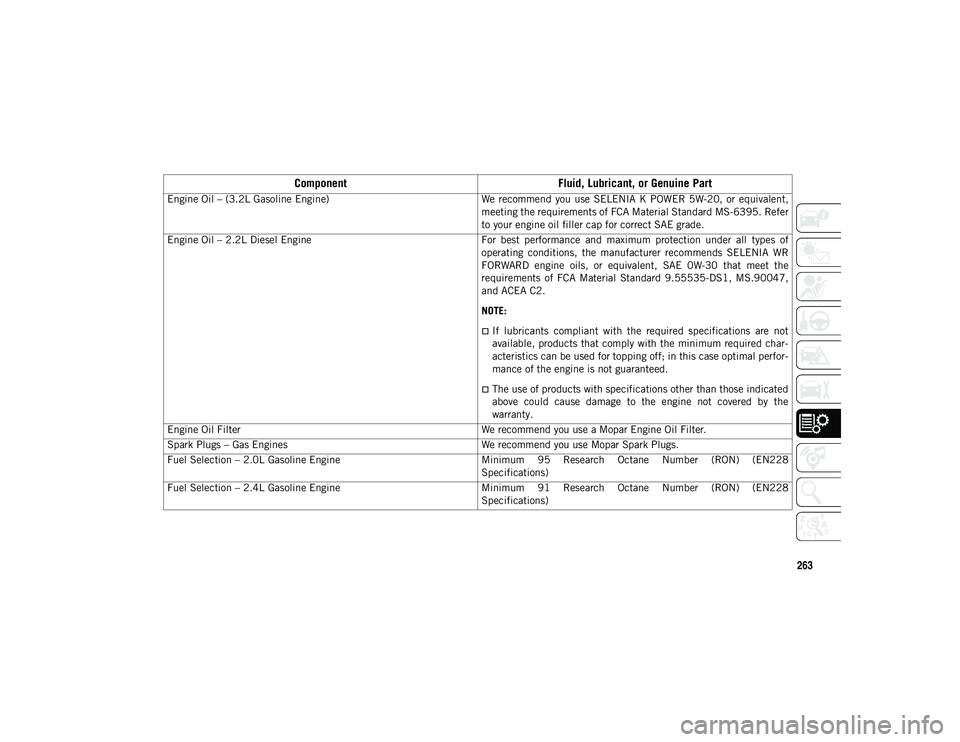
263
Engine Oil – (3.2L Gasoline Engine)We recommend you use SELENIA K POWER 5W-20, or equivalent,
meeting the requirements of FCA Material Standard MS-6395. Refer
to your engine oil filler cap for correct SAE grade.
Engine Oil – 2.2L Diesel Engine For best performance and maximum protection under all types of
operating conditions, the manufacturer recommends SELENIA WR
FORWARD engine oils, or equivalent, SAE 0W-30 that meet the
requirements of FCA Material Standard 9.55535-DS1, MS.90047,
and ACEA C2.
NOTE:
If lubricants compliant with the required specifications are not
available, products that comply with the minimum required char-
acteristics can be used for topping off; in this case optimal perfor -
mance of the engine is not guaranteed.
The use of products with specifications other than those indicated
above could cause damage to the engine not covered by the
warranty.
Engine Oil Filter We recommend you use a Mopar Engine Oil Filter.
Spark Plugs – Gas Engines We recommend you use Mopar Spark Plugs.
Fuel Selection – 2.0L Gasoline Engine Minimum 95 Research Octane Number (RON) (EN228
Specifications)
Fuel Selection – 2.4L Gasoline Engine Minimum 91 Research Octane Number (RON) (EN228
Specifications)
ComponentFluid, Lubricant, or Genuine Part
2020_JEEP_CHEROKEE_UG_RHD_UK.book Page 263
Page 328 of 332
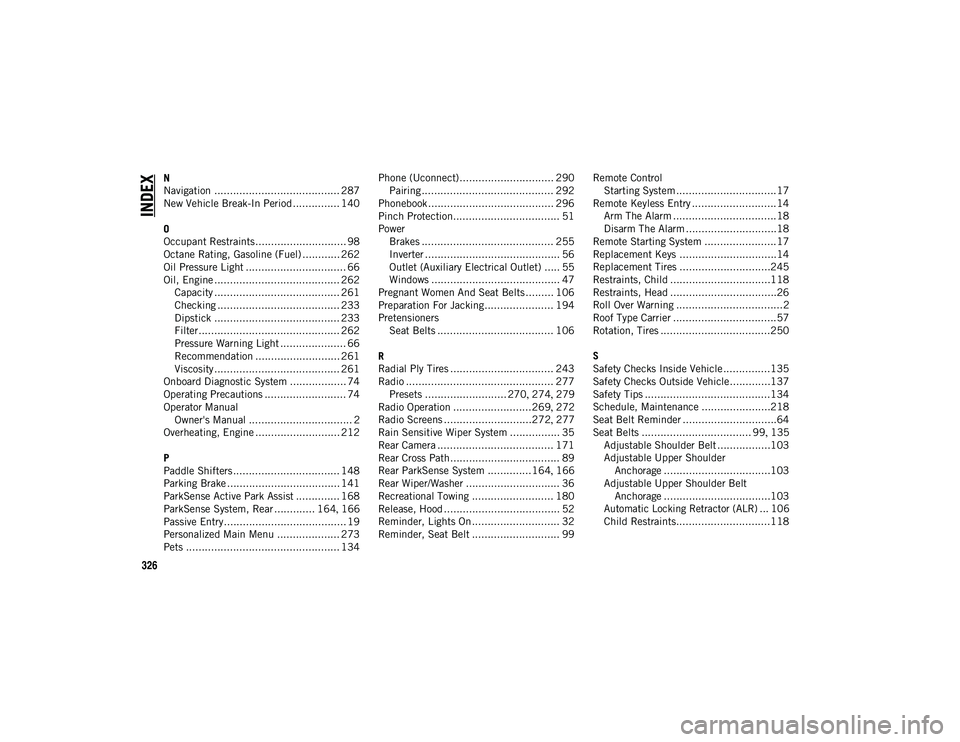
326
INDEX
N
Navigation ........................................ 287
New Vehicle Break-In Period ............... 140
O
Occupant Restraints............................. 98
Octane Rating, Gasoline (Fuel) ............ 262
Oil Pressure Light ................................ 66
Oil, Engine ........................................ 262 Capacity ........................................ 261
Checking ....................................... 233
Dipstick ........................................ 233
Filter............................................. 262
Pressure Warning Light ..................... 66
Recommendation ........................... 261Viscosity ........................................ 261
Onboard Diagnostic System .................. 74
Operating Precautions .......................... 74
Operator Manual Owner's Manual ................................. 2
Overheating, Engine ........................... 212
P
Paddle Shifters .................................. 148
Parking Brake .................................... 141
ParkSense Active Park Assist .............. 168
ParkSense System, Rear ............. 164 , 166
Passive Entry....................................... 19
Personalized Main Menu .................... 273
Pets ................................................. 134 Phone (Uconnect).............................. 290
Pairing .......................................... 292
Phonebook ........................................ 296
Pinch Protection.................................. 51
Power Brakes .......................................... 255
Inverter ........................................... 56
Outlet (Auxiliary Electrical Outlet) ..... 55
Windows ......................................... 47
Pregnant Women And Seat Belts......... 106
Preparation For Jacking...................... 194
Pretensioners Seat Belts ..................................... 106
R
Radial Ply Tires ................................. 243
Radio ............................................... 277 Presets .......................... 270 , 274 , 279
Radio Operation .........................269 , 272
Radio Screens ............................272 , 277
Rain Sensitive Wiper System ................ 35
Rear Camera ..................................... 171
Rear Cross Path................................... 89
Rear ParkSense System ..............164 , 166
Rear Wiper/Washer .............................. 36
Recreational Towing .......................... 180
Release, Hood ..................................... 52
Reminder, Lights On ............................ 32
Reminder, Seat Belt ............................ 99 Remote Control
Starting System ................................17
Remote Keyless Entry ...........................14 Arm The Alarm .................................18
Disarm The Alarm .............................18
Remote Starting System .......................17
Replacement Keys ...............................14
Replacement Tires .............................245
Restraints, Child ................................118
Restraints, Head ..................................26
Roll Over Warning ..................................2
Roof Type Carrier .................................57
Rotation, Tires ...................................250
S
Safety Checks Inside Vehicle ...............135
Safety Checks Outside Vehicle.............137
Safety Tips ........................................134
Schedule, Maintenance ......................218
Seat Belt Reminder ..............................64
Seat Belts ................................... 99 , 135
Adjustable Shoulder Belt .................103
Adjustable Upper Shoulder Anchorage ..................................103
Adjustable Upper Shoulder Belt Anchorage ..................................103
Automatic Locking Retractor (ALR) ... 106
Child Restraints..............................118
2020_JEEP_CHEROKEE_UG_RHD_UK.book Page 326